By Susan Hawkins
I have long admired famous Kipling’s poem “If”; however, it ends “And—which is more–you’ll be a Man, my son!” with its short 32 lines clearly focusing on men. For years I wondered what “If” for women would look like until I realized there’s a work of art channeling the same values, teaching the same lessons and calling our Daughters to the same moral heights. This work is not a poem; it’s definitely longer than Kipling’s 32 lines (so is this review!), but, as you’ll see, it contains the same message.
Director Tim Burton accomplished on film what Rudyard Kipling accomplished poetically—they both spoke to children about living a life of honesty, integrity and courage. Apparently, the planet has been losing its grip on these attributes since the beginning of time. Maybe it just seems more evident now because technology allows us to see the worst of humankind around the world at the touch of a button. Rudyard Kipling used pen and ink and spoke to sons everywhere. In “Alice in Wonderland,” Tim Burton speaks to our daughters through film, and the similarities are remarkable.
A Bit About the Movie
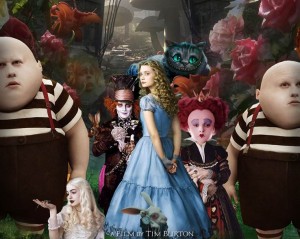 If you haven’t seen Burton’s version of Alice in Wonderland with Johnny Depp as the Mad Hatter, you’re missing a visual orgasm. The film, scripted by Linda Woolverton, is not another version of the story; it’s a reimagined Alice, who returns to Underland (which she had called Wonderland) as a young woman, reunites with her old friends and learns of her true destiny: to end the Red Queen’s reign of terror. Characters from Lewis Carroll’s Alices’ Adventures in Wonderland and Through the Looking Glass (the White Rabbit, the Mad Hatter, the Cheshire cat, the Red Queen and others) join characters from Carroll’s famous nonsensical poem Jabberwocky (the frumious—filthy, with a very bad smell—Bandersnatch and the Jabberwocky himself), creating an intriguing plot line.
If you haven’t seen Burton’s version of Alice in Wonderland with Johnny Depp as the Mad Hatter, you’re missing a visual orgasm. The film, scripted by Linda Woolverton, is not another version of the story; it’s a reimagined Alice, who returns to Underland (which she had called Wonderland) as a young woman, reunites with her old friends and learns of her true destiny: to end the Red Queen’s reign of terror. Characters from Lewis Carroll’s Alices’ Adventures in Wonderland and Through the Looking Glass (the White Rabbit, the Mad Hatter, the Cheshire cat, the Red Queen and others) join characters from Carroll’s famous nonsensical poem Jabberwocky (the frumious—filthy, with a very bad smell—Bandersnatch and the Jabberwocky himself), creating an intriguing plot line.
Alice, age 19, is at her surprise engagement party on the lawn of a lord’s manor just outside London. In front of dozens of guests, a young, unattractive, snarky English lord asks forAlice’s hand in marriage. At that moment, she spots the White Rabbit.Alice, looking for any excuse not to answer, bolts and the adventure is on. Alice falls down the rabbit hole and finds herself back in “Wonderland,” where she’s clearly been expected for some time. It seems the Oraculum, a compendium of time in Underland, shows Alice wielding the powerful Volpol sword and slaying the Jabberwocky (the Red Queen’s ultimate weapon, a fierce and fiery, winged dragon-like creature who, like many of Underland’s creatures, can speak), thereby restoring the crown from the evil (“Off with their heads!”) Red Queen to the beautiful, benevolent White Queen. Will Alice, who insists “I don’t slay!”, save Underland as foretold? Let’s find out, and while we’re at it, we’ll see how Burton channels Kipling for girls.
If You Can Keep Your Head When All About You Are Losing Theirs and Blaming It On You…
How ironic that the first line of Kipling’s poem talks about people losing their heads. Beheadings are the Red Queen’s favorite pastime. But the scene in the movie that corresponds to these words is at the beginning of Alice’s journey. It’s Gribling Day according to the Oraculum, when Alice is supposed to return to Underland. She’s small, having drunk the potion (Pishsalver) that said “Drink Me,” and she’s gone through the small door into Underland, where she first meets Tweedledum and Tweedledee, the March Hare, the Dormouse and a couple of snobbish talking flowers, none of whom are convinced that the White Rabbit brought “the right Alice.” They were expecting a child.
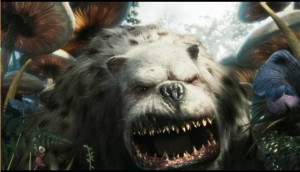 While they’re quibbling, Alice says, “How can I be the wrong Alice? This is my dream.” Suddenly, that doesn’t matter, because the malevolent Red Queen (Iracebeth) has sent the Red Knight, her army of red playing cards and the frumious, enormous (at least, to a two-foot-high Alice) Bandersnatch in search of her, putting all those near her in danger. The Red Queen’s henchmen think they’re looking for a child. The Bandersnatch, fur flying, sharp teeth showing, is gaining on her rapidly, when Alice realizes this is her dream and nothing can hurt her. She stops, turns around and faces him. He stops short, growls threateningly and scratches her arm. Just then, the Dormouse plucks out the Bandersnatch’s eye with her tiny sword, rendering him helpless, and Alice is able to escape. Not so, Tweedledum and Tweedledee, who are captured and taken to the Red Queen. While everyone panicked and scattered wildly, Alice found her inner strength, stood up to the Bandersnatch and, with a little help from a friend, escaped the Red Queen’s grasp.
While they’re quibbling, Alice says, “How can I be the wrong Alice? This is my dream.” Suddenly, that doesn’t matter, because the malevolent Red Queen (Iracebeth) has sent the Red Knight, her army of red playing cards and the frumious, enormous (at least, to a two-foot-high Alice) Bandersnatch in search of her, putting all those near her in danger. The Red Queen’s henchmen think they’re looking for a child. The Bandersnatch, fur flying, sharp teeth showing, is gaining on her rapidly, when Alice realizes this is her dream and nothing can hurt her. She stops, turns around and faces him. He stops short, growls threateningly and scratches her arm. Just then, the Dormouse plucks out the Bandersnatch’s eye with her tiny sword, rendering him helpless, and Alice is able to escape. Not so, Tweedledum and Tweedledee, who are captured and taken to the Red Queen. While everyone panicked and scattered wildly, Alice found her inner strength, stood up to the Bandersnatch and, with a little help from a friend, escaped the Red Queen’s grasp.
If You Can Trust Yourself When All Men Doubt You, But Make Allowance for Their Doubting, too…
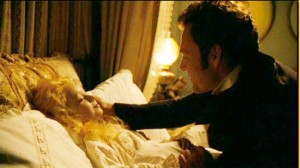 In a way, this is an overarching theme of the film. In the prologue of the film, when Alice is six years old, she wakes from her recurring “nightmare,” and her father, an adventurous international trader contemplating trade with faraway countries, comforts her. She tells him about strange creatures and a talking cat, which Alice believes is impossible. Her father says to her, “The only way to achieve the impossible is to believe the impossible.” Later, when she returns to Underland, almost everyone she meets thinks she’s “the wrong Alice.” Though they doubt her, she insists it’s her dream, and she is Alice, though not the Alice they’re looking for. Even wise Absolem, the blue, monocle-wearing , hookah-smoking caterpillar, tells her she’s “not hardly Alice,” though knows she’s the right Alice, but he also knows she has to discover that fact for herself. For all intents and purposes, Absolem is Alice’s conscience.
In a way, this is an overarching theme of the film. In the prologue of the film, when Alice is six years old, she wakes from her recurring “nightmare,” and her father, an adventurous international trader contemplating trade with faraway countries, comforts her. She tells him about strange creatures and a talking cat, which Alice believes is impossible. Her father says to her, “The only way to achieve the impossible is to believe the impossible.” Later, when she returns to Underland, almost everyone she meets thinks she’s “the wrong Alice.” Though they doubt her, she insists it’s her dream, and she is Alice, though not the Alice they’re looking for. Even wise Absolem, the blue, monocle-wearing , hookah-smoking caterpillar, tells her she’s “not hardly Alice,” though knows she’s the right Alice, but he also knows she has to discover that fact for herself. For all intents and purposes, Absolem is Alice’s conscience.
If You Can Wait and Not Be Tired By Waiting…
It should be pointed out here that, although the film includes events that reflect all of Kipling’s ideals, they don’t necessarily arrive in the same order as the poem. So now, we find ourselves much later in the film, when the White Rabbit tells Alice the location of the Vorpal sword in the Red Queen’s castle. Alice knows the sword has special powers—in essence, she’s looking for her heart—but the sword is locked in a trunk inside the lair of the Bandersnatch, cast aside when his lost eye rendered him ineffective. She finds the Dormouse, also in the castle looking for the Mad Hatter, who gave himself up earlier in the film to protect Alice from capture.
The Dormouse has kept the Bandersnatch eye with her; Alice retrieves it, enters the lair of the creature and, like a bowling ball, rolls his eye toward him from a distance. ”Here’s your eye,” she says. He takes the eye, pops it back in and, instead of attacking, shows he’s grateful by calmly allowing Alice to stay. She uncovers a trunk which, no doubt, contains the Vorpal sword, but it’s locked. It’s late, she’s tired, so Alice, content to wait until morning to solve her problem, lays her head in her arms on the trunk and falls asleep. Alice, now of enormous size (having eaten some Upelkuchen) but still much smaller than the Bandersnatch, awakens to him licking the wound he caused on her arm, clearly in an effort to repay her for returning his eye. When he backs away, she sees the key to the trunk hanging on the chain around his neck. He allows her to take it, she opens the trunk and finds the Vorpal sword. Her patience paid off. Just as Absolem is her conscience, the Vorpal sword is Alice’s heart.
Or Being Lied About, Don’t Deal in Lies…
Alice remains the “wrong Alice” to most of the characters almost until the end of the film. Only the Mad Hatter and Absolem, of course, believe she is the right Alice. Though Alice knows whom she is, she never insists she’s the right Alice verbally, but her actions as she gains courage and resolve during her adventure, prove her to be “right” in the end.
Or Being Hated, Don’t Give Way to Hating, and Yet Don’t Look Too Good Nor Talk Too Wise…
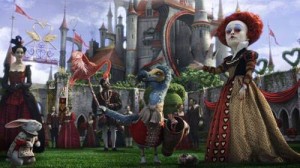 Just after a very tiny Alice has made her way to Salazen Grum (the Red Queen’s fortress) to rescue the Hatter, she navigates the head-filled moat, finds a small crack at the bottom of the massive castle wall, and goes through to find herself behind some shrubs in the courtyard, where the Red Queen is playing a game of croquet. Iracebeth strikes a terrified curled-up hedgehog with an apologetic flamingo (remember, this is Wonderland), sending the hedgehog flying beyond the bushes where Alice is hiding. Iracebeth sends her servant, the White Rabbit, to fetch the “ball.”
Just after a very tiny Alice has made her way to Salazen Grum (the Red Queen’s fortress) to rescue the Hatter, she navigates the head-filled moat, finds a small crack at the bottom of the massive castle wall, and goes through to find herself behind some shrubs in the courtyard, where the Red Queen is playing a game of croquet. Iracebeth strikes a terrified curled-up hedgehog with an apologetic flamingo (remember, this is Wonderland), sending the hedgehog flying beyond the bushes where Alice is hiding. Iracebeth sends her servant, the White Rabbit, to fetch the “ball.”
A bit of exposition here: Virtually all of the Red Queen’s servants and courtiers are her captives, and because they’re miserable in her service, would much prefer to reside in Mamoreal, where the White Queen (Iracebeth’s younger sister) holds court. Because she’s the elder, the “regrettably large head” of Iracebeth wears the crown as the ruler of Underland. Alice doesn’t know it yet, but she’s destined to return the crown to Mirana, the kindhearted White Queen.
When the White Rabbit goes behind the bushes to retrieve the hedgehog, he discovers tiny Alice. “Well, if it isn’t the wrong Alice,” he remarks. She tells him she’s there to rescue the Hatter, but they both know, as the size of a mouse, she won’t have much success. He gives her a square of Upelkuchen, and she grows to an enormous size. The queen walks toward the bushes to find a giant, and barely dressed, Alice. Iracebeth asks the White Rabbit (actual name: Nivens McTwisp) who she is. Flustered, he says, “Um,” the queen says, “Um?” and Alice cleverly chimes in with “From Umbridge.” Because Alice’s head is far larger than hers, Iracebeth has clothes made for her and welcomes Alice into her court.
Alice knows the Red Queen and her loyal knight, Ilosivic Stayne, are looking for her; she is hated and feared by them because they know Alice has returned to Underland to slay the Jabberwocky, but they, too, expect a child. Still, Alice, knowing she’s hated, stays calm in their presence, treating them with respect, and not allowing their red-hot hate to keep her from rescuing the Hatter.
If You Can Dream—And Not Make Dreams Your Master…
To safeguard tiny Alice, the Hatter (actual name: Tarrant Hightopp) gives himself up in the forest between Salazen Grum and Mamoreal. The Hatter and Alice, who travels on the brim of Tarrant’s topper, are making their way to the White Queen when they hear the Red Knight and the armed cards approaching. The Hatter flings his top hat forcefully, with Alice holding on for dear life, to the edge of the forest, where it lands. He shouts “Down with the bloody big head!” to divert attention, and he is captured. She spends the night under the top hat and is awakened in the morning by Bayard, the bloodhound, who is pressed into 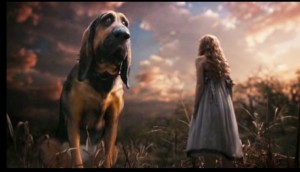 service by Iracebeth because they’re holding his wife and pups in the castle’s dungeon, but he, like the Hatter and many others, is secretly working in Mirana’s behalf.
service by Iracebeth because they’re holding his wife and pups in the castle’s dungeon, but he, like the Hatter and many others, is secretly working in Mirana’s behalf.
Bayard flips over the hat and asks, “Are you Alice?” She replies, “Yes, but not that one,” to which the bloodhound replies, “The Hatter wouldn’t have given himself up just for any Alice.” Bayard tells Alice he’s to take her to the White Queen, but she insists he take her to Salazen Grum so she can free the Hatter, who wouldn’t be there “if it weren’t for me.” It was not “foretold” in the Oraculum, Bayard reminds her: “If you diverge from the path…” to which Alice says, “This is my dream. I make the path!” Alice is clearly the master of her dream.
If You Can Think—and Not Make Thoughts Your Aim…
Alice thinks she’s dreaming through most of her adventure. When she first arrives in Underland, she pinches herself, as her father recommended to wake herself up when she had these recurring dreams as a child, and, of course, she doesn’t wake up. Though wondering why she didn’t awaken after the pinch, Alice doesn’t dwell on it; she lets the dream take her where it will. Otherwise, she would have spent the rest of the film trying to wake up. Perhaps, deep down, she knows, in the end, she’ll find herself.
If You Can Meet With Triumph and Disaster and Treat Those Two Impostors Just the Same…
When Alice falls down the rabbit hole in chase of the White Rabbit, she lands in an enclosed room with a number of doors. In the center of the room is a glass table with a key on it. She takes the key and tries all the doors, but none opens. She then notices a tiny door where the wall meets the floor. Amazingly, the 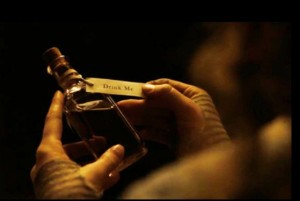 key opens the door, but she’s far too big, so she shuts it. After looking around, she spies a liquid-filled bottle (known as Pishsalver) with a message attached: Drink me. She puts the key on the table, uncaps the bottle and drinks it.
key opens the door, but she’s far too big, so she shuts it. After looking around, she spies a liquid-filled bottle (known as Pishsalver) with a message attached: Drink me. She puts the key on the table, uncaps the bottle and drinks it.
If you know the story of Alice in Wonderland, you know she shrinks to just the right size to pass through the door. Triumph! Unfortunately, she left the key on the now-unreachable table top. Disaster! Persevering, she finds a small cake that says “Eat Me” in icing. She eats a bite and grows so tall she has to bend to fit in the room. Semi-triumph! She’s tall enough to get the key, but far too tall to fit through the tiny door. Disaster! This time, she grabs the key and drinks the potion to return to the tiny size necessary to fit through the door. Neither Triumph nor Disaster affect her efforts to pass through the door—which was truly her only way out.
If You Can Bear to Hear the Truth You’ve Spoken Twisted by Knaves to Make a Trap for Fools…
The Red Knight, Ilosivic Stayne, first encounters Alice when he greets the Red Queen, who’s sitting on her throne, with a very large Alice seated beside her. “And who is this lovely creature?” he asks. “Um,” the queen replies.
“I believe your name has slipped the queen’s mind,” Stayn offers, to which the queen insists, “Her name is Um! Idiot.” A bit later, as Alice is headed to the lair of the Bandersnatch to return his eye, Stayne, quite taken with “Um,” corners her in a hallway, gets in her face and says, “I like you, Um. I like your largeness.” Alice pushes him away and continues her mission, saying “Get away from me.” One of the queen’s courtiers, a woman, sees the interlude and can’t wait to tell the queen what she’s seen and overheard. The queen screams for Stayne, who tells her it was Alice who seduced him. “She’s obsessed with me.” The queen believes him. “Off with her head!” Though Alice is unaware, the queen is now her enemy, and Stayne is sent to “sieze that girl for unlawful seduction!” The knight finds her in the room where she’s about to rescue the Hatter by shattering his chains with the Vorpal sword. It isn’t until the Hatter insists it’s more important that Alice take the Vorpal sword to the White Queen. The Dormouse (actual name: Mallymkun), also there to rescue the Hatter and now, finally realizing that this is, indeed, the right Alice, unwittingly shares that revelation with the Red Knight by shouting “Run, Alice!” And she does, escaping capture.
Or Watch the Things You Gave Your Life to, Broken and Stoop and Build ‘Em Up with Worn-Out Tools…
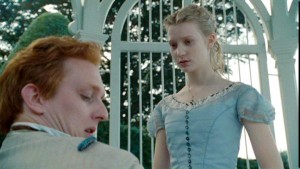 In the film, we first meet 19-year-old Alice with her mother in a horse-drawn carriage, on their way to Alice’s surprise engagement party. Her father, Charles, had passed way, which accounts for his absence. Alice, a product of her father’s unconventional, individualistic view of life, is scolded by her mother for not wearing the proper undergarments (no corset or stockings). She responds to her mother defiantly: “If everyone wore a codfish on their head, would you wear one, too?” We learn from the beginning that Alice isn’t always going to do what’s expected of her, yet she’s now expected to marry a lord she doesn’t even like, much less love.
In the film, we first meet 19-year-old Alice with her mother in a horse-drawn carriage, on their way to Alice’s surprise engagement party. Her father, Charles, had passed way, which accounts for his absence. Alice, a product of her father’s unconventional, individualistic view of life, is scolded by her mother for not wearing the proper undergarments (no corset or stockings). She responds to her mother defiantly: “If everyone wore a codfish on their head, would you wear one, too?” We learn from the beginning that Alice isn’t always going to do what’s expected of her, yet she’s now expected to marry a lord she doesn’t even like, much less love.
In the end, after her adventure in Underland, Alice rebuffs his marriage proposal, promising her mother to build a life for herself. Alice is her father’s daughter, and his uncompromising words, which she took to heart throughout her life, will be her tools.
If you can make one heap of all your winnings
And risk it on one turn of pitch-and-toss,
And lose, and start again at your beginnings
And never breathe a word about your loss…
These lines, with similar meaning to “If you can meet with Triumph and Disaster, and treat those two impostors just the same…” are also represented by Alice’s endeavor to get through the tiny door into Underland. Never once did she whine about her predicament. She perseveres. She risks whatever it takes to get where she wants to go.
If you can force your heart and nerve and sinew
To serve your turn long after they are gone,
And so hold on when there is nothing in you
Except the Will which says to them: ‘Hold on!”
We now find ourselves at the film’s climax, the battle between Alice and the Jabberwocky.
Knowing that Alice has returned the Vorpal sword to complete the armor in the White Queen’s castle, the Red Queen commands that the Jabberwocky be prepared for battle. “We’re going to visit my little sister.” Everyone in Mamoreal, including the Mad Hatter, the Tweedles, the Dormouse, Bayard the Bloodhound and his wife and pups, all who have escaped the Red Queen, expects Alice to come forward as the Champion of the White Queen and slay the Jabberwocky. When asked who will be her champion, the Hatter, the Tweedles and the Dormouse step forward. The crowd and the queen look to Alice, and the queen instructs her, “Do not live your life 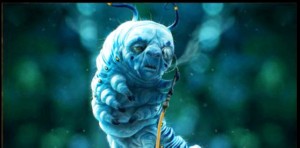 to please others because, when you step out to face that creature, you will step out alone.”
to please others because, when you step out to face that creature, you will step out alone.”
If we suppose that the Jabberwocky is a metaphor for life’s greatest obstacles and challenges, we understand why Alice, or anyone for that matter, is reluctant to jump into danger willingly. Alice runs off to another part of the palace courtyard, where she encounters Absolem the Caterpillar for the last time. She doesn’t see him right away. His chrysalis, almost complete, is hanging from the limb of a tree. She’s pacing and crying, finally sitting down on a bench next to the tree, when she hears Absolem say “Nothing was ever accomplished with tears.” Here’s the rest of their conversation (somewhat paraphrased):
Alice: “Absolem? “Why are you hanging upside down?”
Absolem: “I’ve come to the end of this life.”
Alice: “You’re going to die?”
Absolem: “Transform.”
Alice: “But you can’t leave. I don’t know what to do. I need your help”
Absolem: “I can’t help you if you don’t even know who you are, stupid girl.”
Alice (boldly): “I’m not stupid! My name is Alice. I live in London with my mother Helen and my sister Margaret. My father was Charles Kingsleigh. He had a vision that stretched halfway around the world, and nothing ever stopped him. I’m his daughter. I’m Alice Kingsleigh.”
Absolem: “Alice, at last! You were just as dim-witted the first time you were here. You called it ‘Wonderland’, as I recall.”
Alice: “Wonderland.”
At this point, Alice flashes back to her visits to Wonderland as a child. She realizes it isn’t a dream, and she understands that she’s there to save Underland.
Alice: “It wasn’t a dream at all. This place is real!”
Absolem: “Remember, the Vorpal sword [Alice’s heart] knows what it wants. All you have to do is hold on to it.”
By now, the Red Queen, her minions and the Jabberwocky have reached the giant, checkerboard battlefield that sits just outside Mamoreal. The White Queen dismounts from her horse and walks toward her sister Iracebeth, who has been helped out of her red card-carried sedan chair by the Red Knight. They meet in the middle, and Mirana, whose vows prevent her from harming any living creature, attempts to settle the situation amicably.
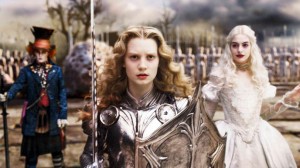 “No,” screams the Red Queen, “it is my crown! I am the eldest! Jabberwocky!” Then the Red Queen arrogantly asks, “Where’s your champion, Sister?”
“No,” screams the Red Queen, “it is my crown! I am the eldest! Jabberwocky!” Then the Red Queen arrogantly asks, “Where’s your champion, Sister?”
Mirana looks back, still not sure who will step forward, when Alice comes out of the castle, riding on the back of the Bandersnatch. She’s dressed in armor from the neck down, and she’s holding the Vorpal sword. To answer Iracebeth’s question, Alice says, “Here.”
Everyone moves back except Alice and the Jabberwocky, who says, “So, my old foe. We meet on the battlefield once again.“
Alice replies, “We’ve never met.”
And the Jabberwocky counters, “Not you, insignificant bearer. My ancient enemy, the Vorpal one.”
Alice, reaching inside herself, says, “That’s enough chatter,” and she promptly cuts off the tongue of the Jabberwocky with the Vorpal sword. The battle is on, and it’s one for the ages.
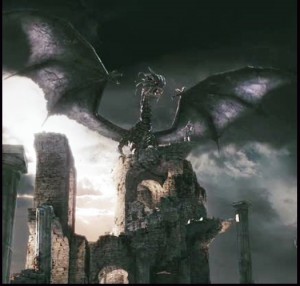 Alice is tossed in the air by the Jabberwocky’s tail, loses the sword, regains it, hides behind columns to avoid the electrically charged, fiery breath of her opponent, runs up a stone, spiral staircase—the sky-high ruins of a now-demolished edifice—almost falling when part of the staircase is missing, but she hangs on and makes it across the gap. Dodging great pieces of stone as the Jabberwocky’s wings and tail demolish the staircase to get at his prey, Alice reaches the final step and can go no further. It appears as if she’s outmatched when she comes face- to-face with the Red Queen’s champion.
Alice is tossed in the air by the Jabberwocky’s tail, loses the sword, regains it, hides behind columns to avoid the electrically charged, fiery breath of her opponent, runs up a stone, spiral staircase—the sky-high ruins of a now-demolished edifice—almost falling when part of the staircase is missing, but she hangs on and makes it across the gap. Dodging great pieces of stone as the Jabberwocky’s wings and tail demolish the staircase to get at his prey, Alice reaches the final step and can go no further. It appears as if she’s outmatched when she comes face- to-face with the Red Queen’s champion.
As the creature crouches down to spread his wings and savor his imminent victory, Alice jumps onto his long neck. He flings her into the air above, where she readies the Vorpal sword in both hands high over her head and shouts, “Off with your head!” Down she comes, separating the Jabberwocky’s head from his body, which plummets to the ground. If that’s not forcing your heart and nerve and sinew to’ hold on’, what is?
The disappearing Cheshire Cat (actual name: Chessur) invisibly lifts the crown off the Red Queen’s huge head and reappears as he places the crown on the head of the White Queen. Mirana banishes the Red Queen and her knight to the outlands, where no one is to speak a word to her. Finally, all is as it should be in Underland.
If You Can Talk With Crowds and Keep Your Virtue, ‘Or Walk With Kings—Nor Lose the Common Touch…
Alice’s demeanor with both queens was no different than her demeanor with every other character in the story. She treated everyone as an equal.
If Neither Foes Nor Loving Friends Can Hurt You…
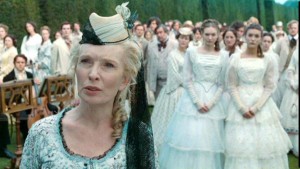 We’ve already learned that her foes can’t hurt her, and Alice also stands up to her loving family and friends, who might inadvertently, yet potentially hurt her by arranging her marriage to a man who’s “not the right man for me.” So Alice says when she turns down the future lord after returning from her adventure in Underland. She also proceeds to set everyone else straight.
We’ve already learned that her foes can’t hurt her, and Alice also stands up to her loving family and friends, who might inadvertently, yet potentially hurt her by arranging her marriage to a man who’s “not the right man for me.” So Alice says when she turns down the future lord after returning from her adventure in Underland. She also proceeds to set everyone else straight.
To her sister, Margaret, who had told Alice she wouldn’t do better than a lord: “This is my life, Margaret. I’ll decide what to do with it.”
To her mother, Helen: “Don’t worry, Mother. I’ll find something useful to do with my life.” And, indeed, she does.
If All Men Count With You, But None Too Much…
Well, in Alice’s case it was queens, knights, a disappearing cat, a Mad Hatter, a Dormouse, a wild-and-whacky March Hare, a White Rabbit, the lord and lady of an English manor, and other quirky characters, all of whom Alice treated with dignity and respect, no matter what was transpiring.
If you can fill the unforgiving minute
With sixty seconds’ worth of distance run,
Yours is the earth and everything that’s in it,
And—which is more—you’ll be…
A fitting ending to both the poem and the film! After Alice’s stirring speech about how she will “find something useful to do” with her life, Lord Astor, father of the young man who asked for Alice’s hand and the new owner of Charles Kingsleigh’s trading company, saw a spark of fire. He and Alice’s father had been good friends for many years, but the lord wasn’t willing to invest his money in what he thought were Kingsleigh’s flights of fancy—particularly extending trade routes halfway around the world to Sumatra and Borneo.
As Alice concludes the polite admonition of her sister, her mother, Lady Astor (who hates white rabbits), and a couple of others who saw fit to intrude upon her life, Lord Astor says, “You’ve left me out.” Alice replies, “No, I haven’t, sir. You and I have business to discuss.”
They go to the lord’s study, where Alice tells him she doesn’t believe her father was thinking far enough. “Why not go all the way to China? It’s vast, the culture’s rich, and we’d have a foothold in Hong Kong! Can you imagine it?”
If anyone else had said that to him, he would have brushed it aside, but “I’ve seen that look before. As you’re not going to be my daughter-in-law, perhaps 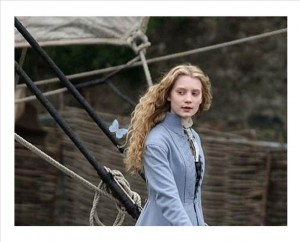 you’d consider becoming an apprentice with the company.”
you’d consider becoming an apprentice with the company.”
The film ends with Alice, transformed, boarding a frigate headed for China. She takes with her the confidence and courage born of her amazing experience in Wonderland. Alice stands on the bow of the ship as it leaves port, facing her future, when a beautiful, blue butterfly lands on her shoulder.
“Hello, Absolem,” Alice says in greeting. He flies off and leads the way to her future—as she follows her heart and admirably fills every unforgiving minute tomorrow has in store for her.
And that’s how filmmaker Tim Burton inspires in our daughters the same ideals Rudyard Kipling inspires in our sons.
Wow! I really want to watch the movie now! I did read Alice in Wonderland when I was a kid, but never saw any movie versions. Thank you Sue for a very perceptive review. By the way, I really like your website.
Thanks, Your Highness! If you’re only going to see one movie version, this would be the one! I wish you could see the movie in its original 3-D, but it’s wondrous either way. So glad you like the Web site, too! We have lots of great stuff in store for you!
Thank you Sue. I am taking your advice. My friend has a 12′ screen and has movie nights every few weeks, so I have asked him to add Alice in 3D to our movie schedule! Will let you know what I think after I see it!
Oooh, boy! Twelve feet. I wish I could be there, too! Enjoy!